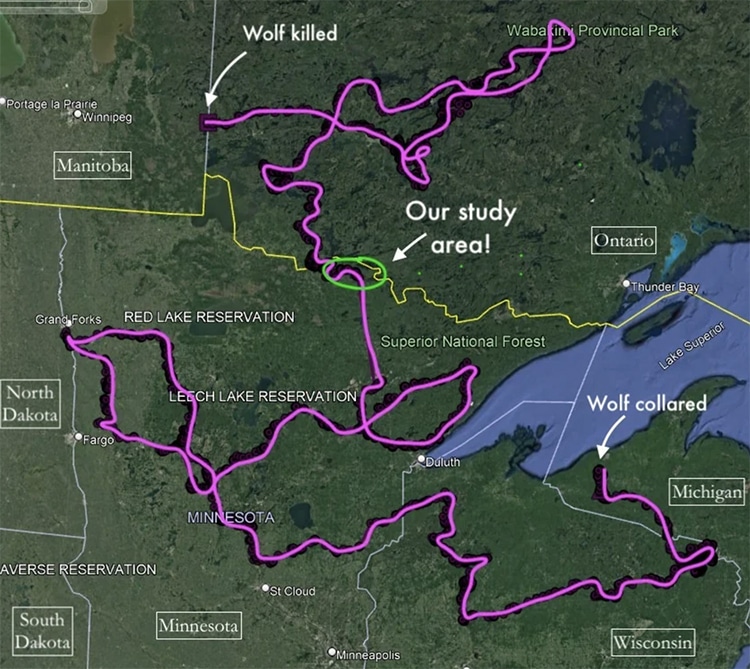
Photo: IZANBAR/Depositphotos (Not a photo of the actual wolf.)
Migration is a fundamental part of life, and an annual routine for much of the animal kingdom. Humpback whales and orcas travel thousands of miles to feed, while tigers can travel hundreds of miles in search of mates. Many animals—including mountain lions and other species native to North America—are feeling the crunch of human encroachment on their wild domains. Gray wolves too are great travelers. One lone wolf recently set a shocking record of 4,200 miles traveled around the great Lakes Region, according to his GPS collar. This journey was spread out over an 18-month period.
Gray wolves, an umbrella species with many varieties across the world, are wanderers by nature. Males in particular like to spread out and search for their own territory. The Michigan Department of Natural Resources collared a male wolf in the Upper Peninsula of the state on June 21, 2021. This is a practice they have pursued since 1992 in order to learn more about the species and track their well-being. However, this 92-pound wolf led them on an 1.5-year journey that outstripped any seen before.
The wolf first trotted south into Wisconsin for the summer. He then traversed the northern part of the state, before entering Minnesota south of Lake Superior. Then the mammal made a figure-8 loop, ducking into North Dakota before again crossing Minnesota. From there, he entered Ontario, Canada, through Voyageurs National Park. He took a northern route through the forests of Quetico Provincial Park, going as far north as Wabakimi Provincial Park. The wild wanderer then came back through Quetico Park before turning west across the province and into neighboring Manitoba’s Whiteshell Provincial Park. In that park, the gray wolf was unfortunately shot and killed by a hunter on December 6, 2022. The hunter who killed the wolf did so legally and said he did not see its GPS collar before he shot it. However, the sad end to the wolf’s long, record-breaking journey has struck many on the internet.
“It never really settled down,” DNR biologist Brian Roell said. “Often it seems like some of these wolves are destined to stay loners.” He also noted, “The use of GPS collars will certainly add more insight to movement of these amazing animals and likely show that others may make similar movements over time… But I suspect this will stand as a record for some time for Michigan.” Despite the sad ending for this wolf, long journeys are not uncommon among his species. Another male Michigan wolf made it 2,000 miles before dying by car.
As researchers continue to learn more about this species, you can advocate for critters who are feeling the space crunch caused by humans. You can let your state and local legislators know that you encourage and support wildlife overpasses to allow for free movement of animals, big and small.
A lone gray wolf traveled 4,200 miles around the Great Lakes region, as tracked by its GPS collar, setting a new record for the species.
Wolves are among certain types of species—including humpback whales and mountain lions—that can travel great distances, sometimes bumping into humans and human-created obstacles.

Photo: DESSINSJEANLANDRY.GN/Depositphotos (Not a photo of the actual wolf.)
This particular wolf’s journey through the U.S. and Canada sadly came to an end when a hunter shot it in Manitoba.

The wolf’s 4,200-mile route. (Photo: Voyageurs Wolf Project)
h/t: [Outdoor Life]
Related Articles:
28 Strange Animals You Didn’t Know Existed
Snowy Owl Makes a Surprise Appearance in Southern California Town
Gray Whale Gives Birth in Front of Whale Watching Boat
Camera Catches Adorable Raccoon Trying to Catch Snow With His Hands
